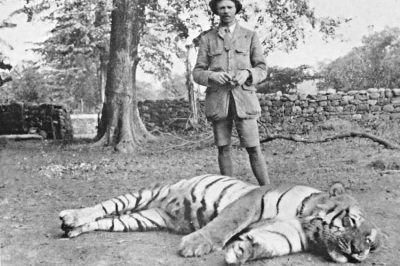Champawat Tiger: The Killer of 436 Humans is a Case of Animal-Need Pitted against Human-Greed
Share

The head of Champawat Tiger. (Nihal Neerrad S / Wikimedia Commons)
Today, the Asian Tigers are a threatened species with just about 3200 thriving units. The number was a lakh (hundred thousand) a century back. The most numerous subspecies, Bengal Tigers, is reduced to 2500 and is also endangered according to IUCN. Man’s itch for infrastructure development and professional hunting has led to this drastic depletion. Tigers are not the natural enemies of man, but may turn on him following injury, and the exigencies of living space. The story of the Champawat tiger, a Bengal tigress that killed 436 humans, is a classical example.
The killing started in Nepal and extended to Kumaon
In the 19th century British ruled India, a Bengal tigress in the Himalayan range of Western Nepal turned into a man-eater. A man of Tharu tribe from Rupal village was her first victim. Professional hunters were called and put on the mission to kill the tigress. But the tigress was too swift and cunning to be caught. Next, in an upscale measure, the army was put on job. Army gheraoed the tigress (who, post her death much later, would be named as Champawat Tiger), but she escaped by crossing over to an adjoining habitat.
Kumaon district, across river Sarda, became her new home, and a terror zone for the natives living there. For seven years, the tigress struck men women and children with brazen audacity, even during the day time, if the opportunity presented itself. An estimated 436 humans fell prey to the deviant wild cat.
Only hassled and handicapped tigers attack men
Tigers normally don’t attack humans for food. They do so only in some exceptional circumstances. In the case of Champawat tiger, it was a hunter’s bullet that failed to kill her but smashed her upper and lower right canines. This injury constrained her from catching its natural prey. And the pangs of hunger forced the tigress to an easier catch, the humans. Another contributing factor was the rampant deforestation done by the British government. The exercise done in the name of infrastructure development was a direct infringement on the living space of the wildlife.
Verily, a fight between man and nature
As man was busy asserting his power on nature, the Bengal tigress was out asserting her power on mankind. Best time for the kill was the day time, when men moved out for work. So, most of her attacks occurred during the day. Even those who rested in the 4 walls of their homes, weren’t spared. Human habitation became her food-spread which she walked into whenever hungry.
Surreptitious killings created mayhem
Ferocious canine teeth, brute power and the quick reflexes of a tiger can freeze any human with fear. The ears of a tiger can hear a wide range of frequencies from 0.2 kHz to 100 kHz, they also have a strong sense of smell. Ears can also rotate on base to catch sound from a particular direction. These endowments make the big cat a stealth killer. Time and again skilled hunters, police and military were engaged to kill the tigress, but to no avail. Orthodox and the God-fearing natives even started believing that it was some kind of a curse from the nether world. Gripped with fear, people stopped moving out of homes. Ironically, even homes weren’t safe. The tigress attacked people sleeping in huts, travelling on boats and even those who perched on trees.
Finally, the British administration couldn’t take it any longer. In the year 1907, the deputy commissioner of Nainital, Charles Henry Berthoud, was determined to do ‘something’. He went out to meet his friend, Jim Corbett.
Jim Corbett was tasked to kill the man-eater
Jim Corbett was a renowned hunter and a railroad worker of Irish lineage. Born and brought up in Kumaon hills, he had spent quality time with native hunters of Kaladhungi forests. Killing of a leopard at the age of 10 was his first landmark, and many more would follow. Berthoud wanted Jim to go after the Bengal tigress. Even though Jim had no hands-on experience of dealing with a man-eater, he agreed to give it a try. He didn’t have to wait for long to go ahead on the task. A fresh killing was reported just 5 days later. A woman astride a tree, plucking leaves for fodder, was pounced upon and killed. This happened in a town 60 miles away. Jim packed up, took six natives as helpers, and headed towards the town.
Village Champawat became the name and the nemesis
On reaching the destination, he saw villagers in a state of shock. As for the tigress, there were no signs of her. So, he decided to wait and watch. A nearby village, Champawat, was frequented by the tigress in the past. The village would go on to become the nemesis, as well as the enduring identity of the tigress as ‘Champawat tiger’. On the advice of the villagers, Jim moved towards this village and got the ultimate lead, a yet another kill. A 16-year-old girl was mauled by the tigress and dragged deep into the woods. The trail was marked by fresh blood. Jim followed the trail and found the victim’s skirt in a distant valley. In the near vicinity were seen scattered pieces of bones, and a severed human leg. Warm blood was still oozing from the leg. Obviously, the man-eater was somewhere near. The thought gave him a mix of hope and fear, and an alert Jim spent hours sitting in a hideout, his finger pressed to trigger. But the big cat eluded him, and he was forced to return.
Massive manpower was used in the final assault
On the day next, Jim reached the valley with a team of 300 villagers. The team spread out into a wall that forced Champawat tiger in a direction where Jim lay in wait. The human wall screamed, beat drums and used firearms to intimidate the animal. With a pounding heartbeat and loaded gun, Jim was now ready for a tryst with destiny. A tiger leaping with lightning speed would give him only a couple of seconds to take aim and shoot. Missing the aim would cost him life. So, for him, it was a matter of do-or-die.
The beast fell to the second round of firing
The moment of reckoning finally arrived. Jim saw some stripes emerge out of shadows. It was the tigress. Corbett fired a shot, which missed the mark. He fired again, this time it hit the animal. Third shot too was on target. But high on adrenaline, the big cat still surged for an attack. Out of ammunition, Jim ran for his life. Sprinting across the valley as fast as he could, he took a shotgun from a colleague, ran back to the hit-but-alive tiger, and fired a volley of bullets from 20 feet distance. With that, he called it a day.
Champawat Tiger made a world record
Death of the Bengal tigress was widely celebrated. But, for Jim Corbett, it was a solemn occasion. Death of the tiger weighed heavy on his mind even as there was relief and satisfaction of a job done. Post mortem findings revealed her broken canines, the prime reason for her turning into a man-eater. The tigress entered in Guinness Book of world records for killing the highest number of humans, i.e. 436. It is believed she may have killed more, as many cases may have gone unreported.
Many more man-eaters were put to death
Post the killing of the Champawat tiger, Jim Corbett was engaged in the extermination of other man-eating tigers too. The last man-eater he killed was in the year 1938, at 63 years of age. A celebrity, and bestselling author of 6 books, he was an animal lover and a committed conservationist at heart. The declining number of tiger population perturbed him even during his lifetime. So much so, he devoted the last 2 decades of his life for the protection of tiger species. Corbett national park at Nainital, Uttarakhand, committed to protecting the endangered Bengal tiger, is a fitting tribute to this outstanding naturalist, hunter, and lover of the wildlife.
Jim Corbett rooted for the conservation of wildlife
Tigers are “a large-hearted gentleman with boundless courage”, opined Jim. They turn man-eaters when wounded, and in some exceptional circumstances, he added. From the man-eating tigers in the past, to the threatened-with-extinction tigers at present, the time has come a full circle. The need of the hour is to conserve tigers at all cost. Otherwise, as Jim Corbett rightly said: if the tiger goes extinct, India will be poorer.
Enjoyed this article? Also, check out “Jim Corbett: A White Hunter Who Became Saviour of Tigers“.
Fact Analysis:
STSTW Media strives to deliver accurate information through careful research. However, things can go wrong. If you find the above article inaccurate or biased, please let us know at [email protected]













